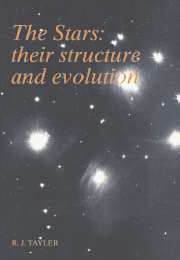Book contents
- Frontmatter
- Contents
- Preface
- Symbols
- Numerical values
- 1 Introduction
- 2 Observational properties of stars
- 3 The equations of stellar structure
- 4 The physics of stellar interiors
- 5 The structure of main sequence stars and pre-main-sequence evolution
- 6 Early post-main-sequence evolution and the ages of star clusters
- 7 Mass loss from stars
- 8 Close binary stars
- 9 Advanced evolutionary phases
- 10 The final stages of stellar evolution: white dwarfs, brown dwarfs, neutron stars and black holes
- 11 Concluding remarks
- Appendix 1 Thermodynamic equilibrium
- Appendix 2 The equation of radiative transfer
- Appendix 3 The pressure of a degenerate gas
- Suggestions for further reading
- Index
5 - The structure of main sequence stars and pre-main-sequence evolution
Published online by Cambridge University Press: 05 June 2012
- Frontmatter
- Contents
- Preface
- Symbols
- Numerical values
- 1 Introduction
- 2 Observational properties of stars
- 3 The equations of stellar structure
- 4 The physics of stellar interiors
- 5 The structure of main sequence stars and pre-main-sequence evolution
- 6 Early post-main-sequence evolution and the ages of star clusters
- 7 Mass loss from stars
- 8 Close binary stars
- 9 Advanced evolutionary phases
- 10 The final stages of stellar evolution: white dwarfs, brown dwarfs, neutron stars and black holes
- 11 Concluding remarks
- Appendix 1 Thermodynamic equilibrium
- Appendix 2 The equation of radiative transfer
- Appendix 3 The pressure of a degenerate gas
- Suggestions for further reading
- Index
Summary
Introduction
In Chapter 2 we have seen that the majority of stars are main sequence stars and I have already suggested that this could mean either that most stars are main sequence stars for all of their lives or that all stars spend a considerable fraction of their life in the main sequence state. It is now believed that the latter is true and that the main sequence phase is one in which stars are obtaining their energy from the conversion of hydrogen into helium which, as we have seen in the last chapter, releases 83% of the maximum energy which can be obtained from nuclear fusion reactions. It is also believed that main sequence stars are chemically homogeneous, which means that there are no significant variations of chemical composition from place to place within the stars. As hydrogen burning is the first important nuclear reaction to occur as the central temperature of a star rises, stars should be chemically homogeneous when they reach the main sequence, provided the same was true of the interstellar cloud out of which they were formed. In this chapter I consider the structure of such stars. In the last two chapters I have discussed all of the relevant equations and have concluded that in general their solution can only be obtained with the use of a large computer.
- Type
- Chapter
- Information
- The StarsTheir Structure and Evolution, pp. 109 - 136Publisher: Cambridge University PressPrint publication year: 1994



